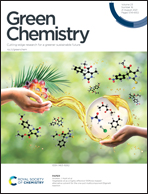Pristine lignin as a flame retardant in flexible PU foam†
Abstract
Typically, pristine lignin is considered to have limited application in the flame retardance area, and the phosphorylation of lignin or its combination with other effective flame retardants is required to help polyurethane achieve flame retardance. Herein, three types of lignin, including sodium lignosulfonate (LS), alkaline lignin (AL) and enzymatic hydrolysis lignin (EHL), were solely applied to significantly enhance the flame retardance and thermostability of PU foams. The PU foam coated with AL or LS could show evidently enhanced flame retardance by growing dense and swelling char, radical capture and inert gas dilution to protect the PU foam from fire and heat, and the limited oxygen index could reach as high as 28.4%. The thermostability of the coated PU foam was significantly improved by retaining 44% of its weight at 900 °C. The flame retardance mechanism of lignin/PU foam was attributed to the fact that lignin could change the thermal degradation and burning behavior of PU foams in the condensed phase (char forming) and the gas phase (inert gas dilution), and by radical quenching (phenolic groups) and S–N synergism. Our research has proved that lignin alone could help PU foam and cotton fabric achieve complete flame retardance, without any phosphorylated modification or the combination with other flame retardant agents.



 Please wait while we load your content...
Please wait while we load your content...